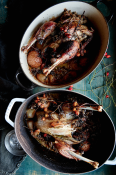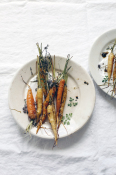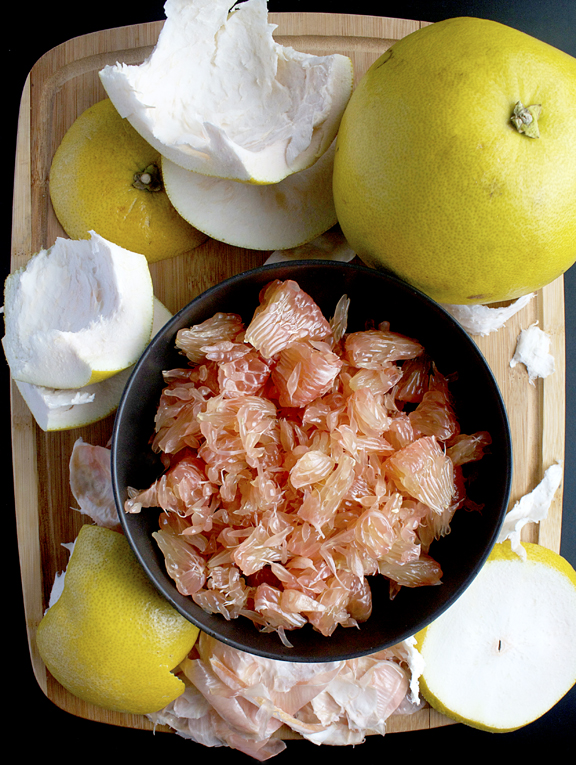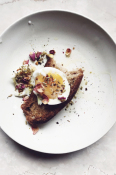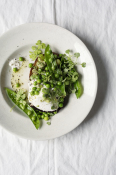All the while, I’d asked Matt to take photos the next time I made oyakodon, a Japanese dish I’d been making a lot lately and one that’s featured in the above-mentioned Lucky Peach book. I thought the images would pair nicely with our conversation. But now as I’m putting this post together, I’m reminded that I first had oyakodon when a friend made it and brought it over for me after Isaac was born and how she told me that it means “parent and child in a bowl” (It’s a chicken-and-egg dish, get it?). The next time I made oyakodon (and Matt got out his camera) ended up being when my mom was visiting. And in case you forgot, a big reason I started this conversation series was to help me handle (come to terms with?) my mom's and my divergent political views. I served up Mom a bowl and Matt caught this on camera. Some might call this kismet? Some might call it something more like: But Amelia, you’re always posting about parent and child stuff. Either way, here's Tannaz and me, two products of our mothers, and a recipe for oyakodon.
Tannaz Sassooni: There's no reason for it. Unless you're forbidden to touch fire for 24 hours. It's a beautiful tradition to shut down for a day and just enjoy life, but getting there is traditionally a lot of work for the family matriarch. The idea of a "Sabbath pot" of some sort is prevalent throughout the Sephardic world. I think in most communities, it's called hamine, but we (Iranians) call it khalebibi, and it's basically a pot of various things (meats, legumes, roots, tubers) that stew overnight to be eaten for the Saturday afternoon meal. There's a Sephardic concept of huevos haminados, which is eggs that sit on top of whatever's in that pot, and khalebibi can have that, too. In the case of Shabbat eggs, it's just the eggs, no big stew in the pot. The texture and flavor here are the antithesis of what's appealing to western palates today. This is nothing like a bright-yolked, oozy, just-set egg. The yolk gets a little powdery. Its edges take on a grey-green. The whites are straight-up beige! And the smell is, well, what you'd expect from eggs boiling forever (although the tea and/or cinnamon helps!). But it's so evocative for a certain generation of Iranian Jews.
AM: Fascinating. Your description reminds me of something I just read about in Everything I Want to Eat where Jessica Koslow talks about one of her inspirations, which is a moment from Jacques Pépin’s old PBS series where he goes through two ways to make an omelette: “the American way” and “the French way,” which Koslow prefers. She describes his French omelette as “the silkiest, supplest, sexiest omelette.” Your Shabbat egg sounds like the opposite! But not in a bad way. Maybe because it's everywhere here on the east side of LA, but I’m a wee bit sick of sexy food. What about you?
TS: I'm not sick of "sexy" food, whatever that means. I have a place in my heart, for sure, for comforting simple flavors that are nostalgic, but I'm not immune to the wiles of bright fresh things, silky textures, big spicy flavors, all of it. I feel like that's so much of the appeal of food—it's sensual. (Side note, I feel like dumplings are the sexiest food of all, and I am HERE for them.) If we're going to anthropomorphize food in this way, I'd say what I am sick of is toxically masculine food! I feel like there's this ongoing thing where, you have to eat the strangest animal, or the strangest part of the animal, or the most insanely spicy thing, to the point where it's not about pleasure at all anymore so much as just being a pissing contest. I don't buy into the mystique that's been created around chefs staying up for crazy hours, doing lots of drugs, being a jerk in the kitchen, then making these perfect specimens of foods in a vacuum. I feel like there's a fetishism to it all (5 years of apprenticeship before they'll deign to let you make the sushi rice?) that's born of privilege, and it doesn't excite me. Countless mothers, for generation after generation, throughout the world, have been cooking high-quality, delicious food for their (often extended) families, balancing nutrition, taste, aesthetics, and budget, not to mention the whims of fussy kids (and grown-ups!), making do with what they have, cleverly stretching what's left from last night into tonight, day after day, and not waiting around for a round of applause. This kind of grounded, aware, art-out-of-necessity cooking is what excites me, and I don't think it gets nearly enough exposure. I guess, as in life, as we get older, what we see as "sexy" becomes richer and far more complex than what the magazines would have you believe.
AM: But Tannaz, I am waiting for my applause! (Unfortunately, only half-kidding.) I like what you say here a lot. It makes me think that it’s not that I’m sick of sexy food or as you describe it: “bright fresh things… and big spicy flavors.” (I immediately think of the hummus platter at Dune in Atwater Village, which is both beautiful and delicious.) I think it’s the media’s obsession with this kind of food I’m sick of. It goes hand in hand with an idea I keep thinking about (shouting about?) ever since the election—this idea of why do we, as a society, seem to value strength (or the appearance of it) over vulnerability? The shiny over the subtle? Being right over being wrong (and being able to admit it and learn from it)? Being decisive over biding one’s time?
It makes me wonder about how to make practicality and receptivity sexy. I think Tamar Adler does this in An Everlasting Meal. But how to get this idea on the cover of Bon Appétit magazine? I don’t know if it translates to imagery. And imagery is why people buy food magazines, right?
TS: I don't know the answer here, but I think you hit the nail on the head with Tamar Adler. An Everlasting Meal is one of my favorite books ever, and perhaps if everyone could write as beguilingly as she does, we'd have no problem. Whenever I think about traditional food and cooking—of those systems that are ingrained in Italian, Vietnamese, Persian, etc. cuisines—I think about how practicality is also built into them. And then I find myself having problems with capitalism. It seems like everything needs to rely on a product, something to sell, when in fact these systems are about efficiently using the simplest things.
My mom makes elaborate meals, which could definitely be classified as sexy, but her footprint is very small. She buys mountains of herbs and picks them off the stalks, chops them herself. There are very few gadgets in her kitchen—why would you need a lemon squeezer when you have a fork? A jar has never left her home for the trash can—all of her spices live in repurposed jars (a fact I hated when I was a kid). She wastes nothing (no seriously, nothing). She has a system, and it's quite spartan, and amazing things come of it! She eludes capitalism. So in a society where the only things that are pushed forward are those that sell products, I don't know how you cultivate this. This fact troubles me.
TS: I haven't read the book yet, but I've been following its development through the instagram of its amazing illustrator, Wendy MacNaughton, and I have no doubt it's amazing. It's a really good question you ask about duty vs. joy. Persian food is without question time-consuming. Technique is a big part of it, and everything is fiddly and "high-touch.” I don't know a single person who is more driven by obligation than my mother; she never complains, she just does what she feels is expected of her, and has for decades. When it comes to big meals, she certainly exhausts herself, but I do feel there are a couple kinds of joy here for her: For one, there's that system. She's got a rhythm down in the kitchen over decades, and I feel like she's perfectly content doing her thing, without interruptions, in a kind of solo meditative state (not to get too hoity-toity about it – she'd never agree with me calling it 'meditative'). Then, she's modest, but I feel like she quietly takes pride in how delicious her food is. I think it's deeply gratifying to be able to make these meals, bring her family together over them, and see how happy it makes them to eat her food and share those experiences.
There's an academic book I read a while back, and it really cleared some things up for me. It's called From the Shahs to Los Angeles: Three Generations of Iranian Jewish Women between Religion and Culture, by Saba Soomekh, a religious studies professor. She interviewed a bunch of Iranian Jewish women for the book, and in it, she talks about how, in my grandma's generation, while the father would study Torah and pray at the synagogue, the way the mother of the family expressed her religiosity was through keeping the family together, making sure the holidays were observed, preparing meals, taking care of the children. I found this really interesting. I love this idea of doing your faith in a practical way as opposed to just chanting. And it turns a lot of ideas about traditional, patriarchal family units, especially religious ones, on their head.
Anyway, I think this carries through in my mother. I'd say that she is around one-hundred percent responsible for keeping our family together and connected. Yes it's an obligation, yes it's definitely hard, constant work, without question. But she's making a profound contribution, and I think this is deeply gratifying to her.
Finally: It's just in her at this point. She always prefers to cook a meal at home than go to a restaurant. It's a fight to get her to go out even for Mother's Day. She knows she's making healthier food and spending less money, and she honestly gets antsy at restaurants. Obligation doesn't necessarily feel like the right word—it's just in her; it's what she does.
AM: I love that she is essentially repelling capitalism at every turn! Not even a restaurant is going to tempt her. That being said and as much as I love to rail against capitalism, I recently listened to Terry Gross’s interview with Billy Bragg and he said something I loved—that the enemy isn’t capitalism or conservatism. It’s cynicism! So with that in mind, can you tell me about a recent hopeful food experience? (Something you read or tasted or a restaurant you visited?)
TS: Back in 2014, I designed the menu for a three-course dinner at a local arts and culture non-profit called Clockshop, which showcased flavors from Iranian Jewish cuisine. There was a young chef in the kitchen there, a native Angeleno of Filipino descent named Chad Valencia, and it blew my mind to see him treat our family recipes, which I'd only ever seen prepared by my mom and grandmas, with the utmost care and respect. He went on to open a restaurant, Lasa, with his brother Chase, where they serve Chad's take on Filipino flavors, and I recently visited. Every bite was seriously delicious, and the innate hospitality in the room made us feel like family. We ended the meal with a dessert called a sans rival, and this particular rendition had brown butter buttercream, chopped pistachios, calamansi-macerated strawberries, and Persian mint. The meal resonated on so many levels, but this story of kids of immigrants taking their inherited legacy, mashing it up with the local bounty – both culinary and cultural – to make something that respects their roots but is also fully of-the-moment, makes my heart swell. It makes me proud of my beloved Los Angeles, and fills me with hope.

Oyakodon adapted from All About Eggs
serves 4
NOTE: I've been meaning to post about this dish for a while now. I've made it probably a dozen times, but I still haven't perfected it. Ideally, I would like the eggs to take on the consistency of a very soft scramble, but instead they often seem to get lost to the sauce. I think this might be more easily avoided if I made it in a 10-inch cast iron pan, but alas I don't have that size. It's not a problem though. We always eat it happily no matter how the eggs come out. My patience is lacking in the kitchen these days, but what I have done in the past is transfer some of the cooked chicken mixture to a separate pan (8-inch cast iron) and then finish the portions individually, adding two beaten eggs on top and getting more of the soft-scramble consistency I want. In this below version, I've followed the Lucky Peach people and made one big pan. I also sometimes start by sautéing the onion and mushrooms in a neutral oil before adding the liquid and chicken. Either way, I totally recommend this dish. It's become one of our weeknight favorites.
2-3 cups short-grain white rice
1 cup chicken broth (Dashi is what's traditionally used here, but I never have it on hand nor the time to make it myself anymore.)
2 tbsp. sugar
1/4 cup shoyu
2 tbsp. sake
1/4 cup mirin (When I don't have mirin, I've used rice vinegar and it's totally worked for me.)
1 onion, halved lengthwise and cut crosswise into thin slices
8 oz. mushrooms (any kind), sliced (optional)
1 lb. boneless and skinless chicken thighs, cut into 1-inch cubes
8 eggs
2-3 scallions, trimmed and chopped (optional)
some manner of greens like watercress or mitsuba sprigs or shiso leaves (optional)
chili garlic sauce or Sriracha (optional)
Cook the rice according to the package directions. While it's cooking, make everything else.
Add the chicken broth or dashi, sugar, shoyu, sake, and mirin to a 10-inch cast iron pan (or something similar) and bring to a boil, stirring to dissolve the sugar. Add the onion, mushrooms, and chicken and cook, stirring occasionally, until the onion is soft and chicken is no longer pink, 3 to 4 minutes.
Lightly beat the eggs in a bowl and stir in the scallions if using them. Reduce the heat to medium-low on the chicken mixture, then pour two-thirds of the eggs and scallions into the skillet and continue cooking until the eggs just start to set around the edges, about 2 minutes. Add the remaining eggs, cover, and let cook for 1 or 2 more minutes, until they look mostly set all the way through. Turn off the heat and let the oyakodon sit for another minute.
Serve over the rice and garnish with the mitsuba or watercress or chopped shiso leaves or whatever other green you think might work. As you can see, Matt likes to eat it with a healthy amount of hot sauce/Sriracha on the side.









